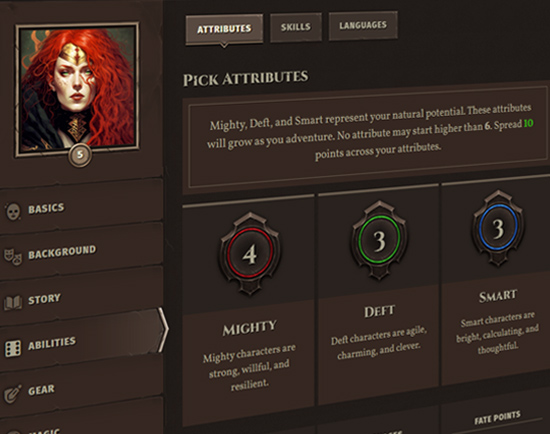Scenes in roleplaying games, unlike their narrative counterparts, don't have beginnings, middles, or ends. When you create a scene, you're staging things for the players to interact with in a particular time and place; after that, you simply react to what the players are doing and update the scene as a result of their actions.
While scenes have a narrative function in the adventure—they're the place where players surface adventure hooks—they're also the most common fictional space that PCs inhabit in the game. Learning how to run a scene and make it immersive enough for players to want to surface those adventure hooks is fundamental to mastering a game of OSR+.
Scene-Setting Techniques
When you set the scene, you want to think from the perspective of the PCs who are there. Command all five senses to describe the scene, but don't present more than three points of interest for them to explore before you hand the spotlight back to them.
Invite Players to Collaborate
If you want to get players immediately immersed in a scene, invite them to help you describe it. You can give them a general vibe for the place they're walking into: "it's a seedy yakuza dive bar in the corpo district's underbelly, full of cartoonish villains inhaling Glimmer like there's no tomorrow."
Rotate the spotlight to each player, and have them add something to the scene that they see in the bar.
Now you might ask yourself: isn't it patronizing to invite my players to add aspects to the scene, when I've already filled it with discoveries? Not if you take a "yes, and" approach to your players' contributions. Sometimes players will add things (or NPCs) to the scene that elevate the discoveries or interactions you've already built into it. By merging their ideas with your own, players become even more invested in interacting with the scene, which means higher chances they'll uncover all the adventure hooks inside.
Reveal Three Points of Interest
Players have incredibly short attention spans. They also have little interest in memorizing long lists of things presented to them in the form of narration.
If your scene is a hot and sweaty nightclub that smells like cotton candy-flavored vapes with pounding techno music and there are five colorful NPCs at various tables and there's a sketchy-looking bartender sitting behind a bar with acrobats doing aerial silk maneuvers overhead and you also know there's a secret trap door to the basement in the creepy bathroom spewing those cotton-candy flavored vape clouds that you hope will be discovered because it leads to the monsters' lair: just stop. You can't describe all this at once! Your players will get bored or become confused.
Three is a magic number. Break up the nightclub into three points of interest:
- sweaty aerial silk acrobats over the bar;
- loud colorful patrons at tables whose chatter you can't hear over the pounding techno music;
- cotton-candy flavored vape clouds spewing out of the bathroom, where illicit shit is probably happening within.
You've now presented three routes into the scene, and your PCs get to decide what they're interested in. The rest of the details you can reveal as the PCs interact with what's out there.
Give Them A Claw Machine to Play with
Remember that this is also a game. Players want to face challenges they can overcome that have a chance of failure (the claw machine). They also want their interaction with the fiction to be rewarding: that is, the more they interact with the fiction, the closer they get to fulfilling their narrative goals (the stuffed toy inside the claw machine).
So the scene always needs something to interact with and something to discover. That's your claw machine in a nutshell.
Creating Interactions in a Scene
You can present the interactions in the form of NPCs, perils, or physical objects. For example, the patrons in the bar and the bartender, if influenced properly, can yield discoveries in the form of information. The bathroom can be inspected and yield a discovery in the form of a secret door (though there are yakuza back there wacked out on drugs who function as a peril). And perhaps the tattooed barcodes on the acrobats' necks yield an adventure hook which indicts a megacorp that the party suspected of secretly financing this whole operation.
Creating Discoveries in a Scene
These discoveries always take one of three forms: adventure hooks that clue the PCs into the existence of other scenes (in this case, the megacorp); resources, like treasure or supplies (perhaps the bartender is willing to sell an illegal computer chip at a discount); or information in the form of intel: context about the adventure in general, or context about themselves usually communicated via downtime (via the patrons).
If your scene doesn't have a claw machine in it, players can't play and they'll (rightfully) be frustrated.
Build on the Scene Reactively
The scene reveals itself only as the players interrogate it. Once you've set the scene, it's up to the players to interact with it and tease out additional details. You don't continue to narrate arbitrarily, and you don't volunteer information in a vacuum, unless the PC is moving into a new space you need to describe.
Expand the Scene Over Time
As they ask questions, that's your opportunity to flesh things out further. And when they ask about something you didn't account for, make things up that logically follow.
For example, if the PCs wander into the cotton-candy vape-filled bathroom, they might look to you for a description of the room. Resort to scene-setting again: three things, at least one of which is a claw machine. We already know the yakuza are our peril, but are there also discoveries to be had? You might decide there are posters stuck up on the bathroom wall that also have the megacorp's barcode stuck to them. Perhaps inside a bathroom stall where the trap door is, a hacker scrawled a cryptograph with secret information.
Yield Discoveries Liberally
As the players interrogate the room, look to your list of discoveries to see if any of them could appear in the place that's being actively interrogated. Every time the player asks you to describe something in the fiction, it's an invitation to yield a discovery. Sometimes there is no discovery to be had (there's just a toilet in the stall), but sometimes it's an opportunity to place a discovery there and reward the player for interrogating the scene. Unless you had a strong narrative reason for the discovery to exist in the place you originally designed it to appear, you always want to reward the player's curiosity.
 Archetypes
Archetypes Armor
Armor Classes
Classes Conflicts
Conflicts Cultures
Cultures Ethos
Ethos Flaws
Flaws Glossary
Glossary Kits
Kits Maleficence
Maleficence Origins
Origins Shields
Shields Skills
Skills Spells
Spells Stances
Stances Status Effects
Status Effects Tactics
Tactics Talents
Talents Techniques
Techniques Treasure
Treasure Weapons
Weapons











 Hall of Heroes
Hall of Heroes Hall of Legends
Hall of Legends



 Dungeons & Flagons
Dungeons & Flagons